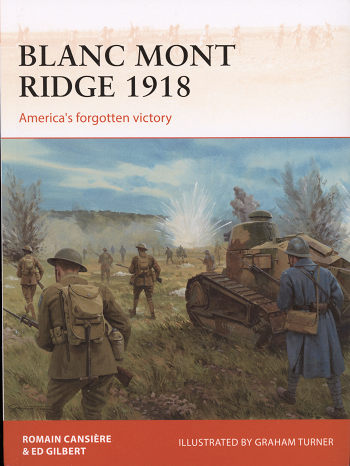 This
latest book is part of Osprey's Campaign series and is undoubtedly the largest
series is Osprey's extensive catalogue. I am not a student of WWI, which
is why I find books like this so interesting though I have heard of most WWI
battles. This is one I did not know existed. In fact, the author states that
this campaign is one that, for whatever reason, is rarely mentioned in histories
of the war and on which nearly nothing has been written. Why this is the case is
a real puzzler as it was a victory for the French and US Marine Corps; an event
that was just as important as the Argonne and Bella Wood. Interestingly, a major
source of information was a German book about the campaign as nothing had been
written by the US and there was no official history of the campaign.
This
latest book is part of Osprey's Campaign series and is undoubtedly the largest
series is Osprey's extensive catalogue. I am not a student of WWI, which
is why I find books like this so interesting though I have heard of most WWI
battles. This is one I did not know existed. In fact, the author states that
this campaign is one that, for whatever reason, is rarely mentioned in histories
of the war and on which nearly nothing has been written. Why this is the case is
a real puzzler as it was a victory for the French and US Marine Corps; an event
that was just as important as the Argonne and Bella Wood. Interestingly, a major
source of information was a German book about the campaign as nothing had been
written by the US and there was no official history of the campaign.
Basically, it is pretty standard WWI battle where plans
start to fall apart as soon as the battle starts. It lasted for about a month of
very heavy fighting with the Germans requiring a rather heavy price for what
ground was taken. For the US side of the battle it was the US's Second Division
which included the 4th Marine Brigade as well as Texas and Oklahoma National
Guard to provide the troops and operated in concert and under the overall
control of the French. The reason for the US troops was that the French troops
were quite war weary and the French generals were concerned that they were not
up to the task without help.
The campaign started with the most experienced Marine
soldiers in the line and eventually brought in green troops from the reserves in
some of the less dangerous sectors to provide them with battle experience. This
experience is very quickly learned if a soldier wants to stay alive. Despite the
usual goofs and glitches, fairly steady progress was made to capture the heavily
defended Blanc Mont high ground that was the main objective of the battle.
Eventually gaining this as an observation area for future advances was a major
plus for the French and Americans.
While it was possible in terms of troops to continue the
advance, logistics determined that this was not possible. A major issue during
WWI was always being able to provide supplies and not just weapons and
ammunition but also food and other materiel. About two weeks after this
campaign, the war was over. An interesting bit of information about this battle
is that it is the first time that Native American code talkers were used. In
this case it was members of the Choctaw Nation that performed this task.
I found this title to be very interesting and learned
quite a bit from reading it. It is well written and helps to clear up the usual
fog of war. There are the usual great period photos as well as useful maps and
other illustrations typical of the series. I liked it and I know you will as
well.
November 2018
Copyright ModelingMadness.com. All rights reserved.
For more on the complete line of Osprey books,
visit www.ospreypublishing.com .
If you would like your product reviewed fairly and quickly, please
contact
me or see other details in the
Note to
Contributors.
 This
latest book is part of Osprey's Campaign series and is undoubtedly the largest
series is Osprey's extensive catalogue. I am not a student of WWI, which
is why I find books like this so interesting though I have heard of most WWI
battles. This is one I did not know existed. In fact, the author states that
this campaign is one that, for whatever reason, is rarely mentioned in histories
of the war and on which nearly nothing has been written. Why this is the case is
a real puzzler as it was a victory for the French and US Marine Corps; an event
that was just as important as the Argonne and Bella Wood. Interestingly, a major
source of information was a German book about the campaign as nothing had been
written by the US and there was no official history of the campaign.
This
latest book is part of Osprey's Campaign series and is undoubtedly the largest
series is Osprey's extensive catalogue. I am not a student of WWI, which
is why I find books like this so interesting though I have heard of most WWI
battles. This is one I did not know existed. In fact, the author states that
this campaign is one that, for whatever reason, is rarely mentioned in histories
of the war and on which nearly nothing has been written. Why this is the case is
a real puzzler as it was a victory for the French and US Marine Corps; an event
that was just as important as the Argonne and Bella Wood. Interestingly, a major
source of information was a German book about the campaign as nothing had been
written by the US and there was no official history of the campaign.